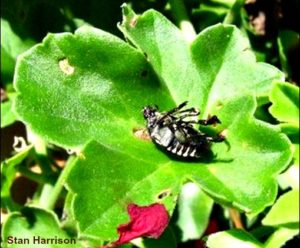
Nature’s Death Trap Paralyzes the Invaders!
Are Japanese beetles destroying your roses? Are they attacking your beans? corn? peppers? grapes? apples? cherries? peaches? plums? blueberries? If so, you are definitely are not alone. It is the rare gardener who escapes an invasion of the voracious metallic green pests, whose sole aim is to devour the leaves of approximately 300 susceptible plants, trees, and shrubs.
But take heart. There is one plant that the Japanese beetle eats at its peril. Fortunately for us gardeners, Japanese beetles find it attractive. What plant is it that lures the Japanese beetle to its death ?
The geranium!
USDA Research
According to scientists at the USDA’s Agricultural Research Service (ARS):
Geraniums may hold the key to controlling the devastating Japanese beetle, which feeds on nearly 300 plant species and costs the ornamental plant industry $450 million in damage each year.
The beetle can feast on wide variety of plants, including ornamentals, soybeans, corn, fruits and vegetables. But within 30 minutes of consuming geranium petals, the beetle rolls over on its back, its legs and antennae slowly twitch, and it remains paralyzed for several hours. the beetles typically recover within 24 hours when paralyzed under laboratory conditions, but they often succumb to death under field conditions after predators spot and devour the beetles when they are helpless. . . .
The poisoning effect of geranium flowers is not a new discovery; it has been reported in scientific papers dating back to the 1920s. But the phenomenon has not been studied in depth—how or why it happens—until recently when ARS scientist picked up in Ohio where scientists left off more than half a century ago.
Currently, Chris Ranger, an entomologist in the ARS research unit in Wooster, is working on a natural botanical formulation for controlling the beetles based on paralytic compounds isolated from geraniums. Patent rights are being pursued. Ranger is collaborating with Ajay Singh, a natural products chemist from Rutgers, The State University of New Jersey.
What Can You Do?
In the meantime, until the natural botanical formulation is commercially available—EXPERIMENT!
- Plant geraniums in strategic area near your plants most susceptible to Japanese beetle attack.
- Hang ivy geranium baskets high throughout your garden.
- See what happens.
Journal It!
 Be sure to record your observations and the results in your garden journal!
Be sure to record your observations and the results in your garden journal!
GARDEN JOURNAL AND PLANNER
by Michelle Marsh
Your Garden Records, Thoughts, Plans
and Pictures — Complete in One Package
Amazon.com: amz.to/2r7zwAb
AmazonUK.com: amzn.to/2LnllyA

